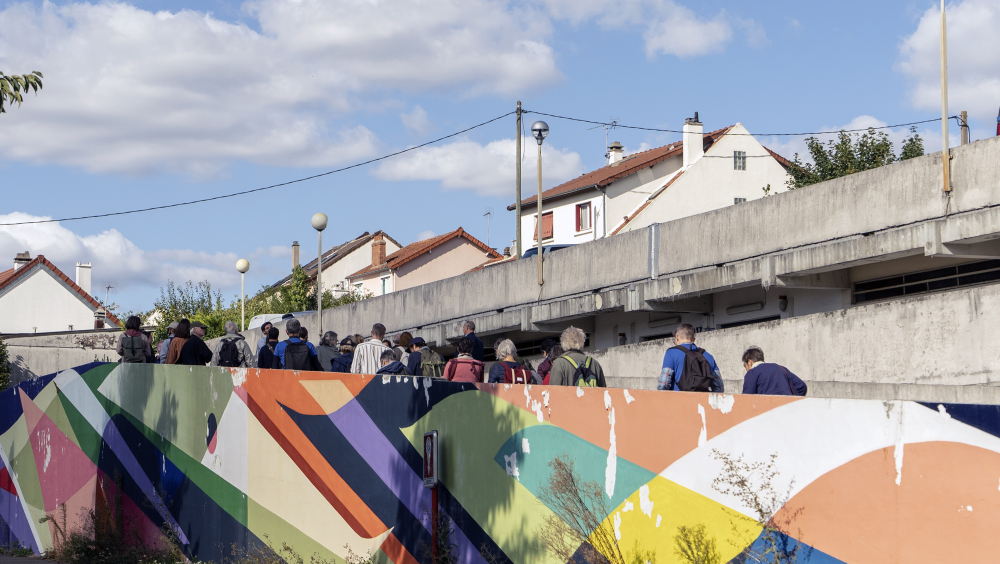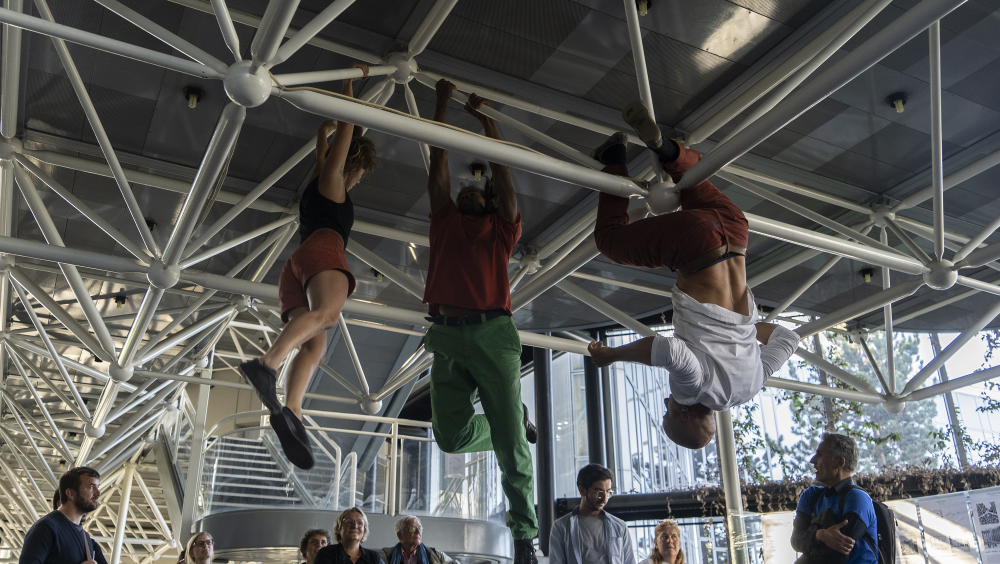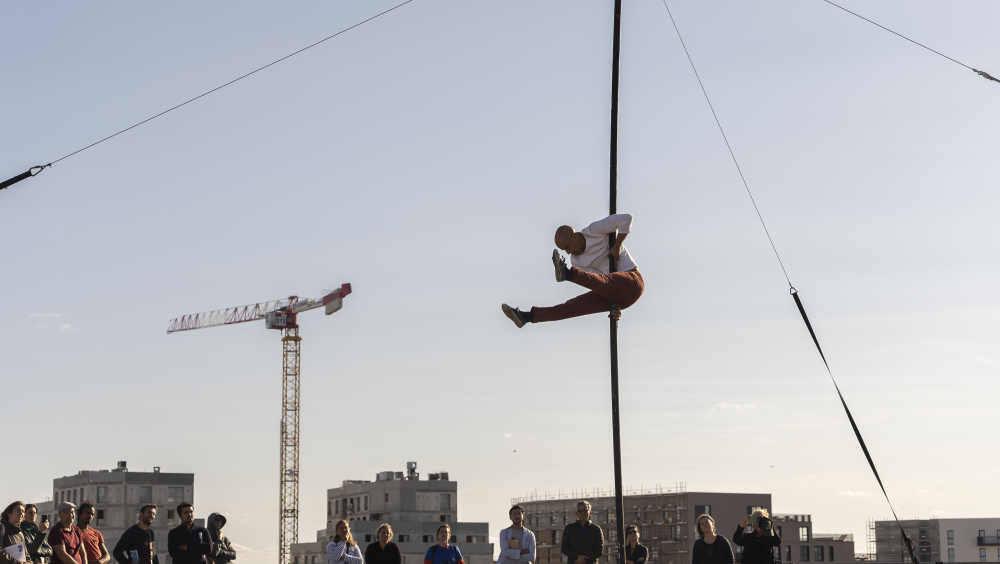The Grand Voyage
The urban peripheries bear witness to a heterogeneous spatial and social reality, both in its architectural, urban and landscape typologies, and in the diversity of its populations. This context makes it a precious but fragile breeding ground for cultural wealth.
The stigmatization of working-class suburban neighborhoods and its inhabitants contributes to the vulnerability of its heritage. In addition, the gentrification dynamics underway in these territories contribute to the increase in the value of rents and land and to the disappearance of heritage and social and cultural projects.
Thus, the heritage value of peripheral urban spaces and their qualities are often unknown and sometimes contested.
The city of Bagneux, and more particularly the priority district of the city policy of Tertres-Cuverons, where PPCM is located, is no exception to these dynamics.
The Grand Voyage is an invitation to (re)discover and highlight the richness and plurality of the tangible and intangible heritage of the territories visited.
"The heritage of the urban peripheries, a factor in the creation of local identities open to the world
The heritage of the urban peripheries is central to the construction of local identities, often in the process of being recomposed, in a context of population movements and the arrival of new residents. These local identities can resonate on a metropolitan scale and beyond, through the relationships they establish with the world."
Extract from the principles of the Manifesto for the Heritage of the Urban Peripheries written by the research programme Una Europa Cultural Heritage Community
The Grand Voyage is a hike that offers to highlight the road, the interval between the start and the finish, the in-between...
Through the practice of walking as a means of travel freed from the constraints pre-established by the communication axes, the Grand Voyage proposes to see what we do not usually see, to take alternative paths, to discover invisible cities...
After 32 years of existence, in the course of a singular cultural, social and territorial adventure, the PPCM became the first National Centre dedicated to the urban peripheries, their heritage, their cultures and their youth. Through this label, the PPCM is committed to promoting the architectural, social and cultural heritage of the cities of the Paris suburbs.
The project to promote the heritage of the peripheries led by the Plus Petit Cirque du Monde presents three lines of reflection that propose to approach the territorial research carried out in a transversal, incremental and interdisciplinary way. It proposes, first, to study the heritage issues of the peripheries in connection with the dynamics of territorial transformations linked to the development of Greater Paris. How can the history of the urban construction of the suburbs and the legacies of migrations and population movements accompany the construction of a more inclusive Greater Paris and mitigate the harms of gentrification? What place for intangible heritage and cultural diversity of young people from working-class neighbourhoods? How does the rehabilitation of the heritage of the peripheries (social housing, industrial wasteland, "urban neglect", historical heritage) make it possible to rethink the ecological transition?
In the Paris metropolis, in France, in Europe, the majority of citizens now live on the outskirts of cities. More than anywhere else, culture is, in these urban neighbourhoods, a driver of social transformation and emancipation. More than anywhere else, the fight against all forms of exclusion makes cultural investment necessary, at a time when the fractures of poverty and fear are likely to deepen. More than anywhere else, the leverage effect produced by this investment is powerful. The suburbs are both a space of fragility and inequality, but also a living source of creativity, solidarity and projects. They are rich in an architectural, industrial, natural and memorial heritage of immense diversity, most often ignored, contested or neglected.
THE GRAND VOYAGE Revealing the heritage of the peripheries
The Grand Voyage is an annual event taking place during the weekend of the European Heritage Days which aims to highlight the polymorphous heritage of the Parisian suburbs. This project, led by the Plus Petit Cirque du Monde in partnership with the CAUE (Council of Architecture, Urban Planing and Environment) of Hauts-de-Seine metropolitan area, proposes to take a new look at our cities and to highlight the heritage character of the suburbs and modern and contemporary buildings. Indeed, the urban peripheries bear witness to a heterogeneous spatial and social reality, both in its architectural, urban and landscape typologies, and in the diversity of its populations. This context makes it a precious but fragile breeding ground for cultural wealth. Indeed, the stigmatization of working-class suburban neighborhoods and its inhabitants contributes to the vulnerability of its heritage. In addition, the gentrification dynamics underway in these territories contribute to the increase in the value of rents and land and, a fortiori, to jeopardize heritage and social and cultural projects. The heritage value of peripheral urban spaces and their qualities are often unknown and sometimes contested. The city of Bagneux, and more particularly the priority district of the city policy of Tertres-Cuverons, where the World's Smallest Circus is located, is no exception to these dynamics. The Grand Voyage is an invitation to (re)discover and promote the richness and plurality of the tangible and intangible heritage of the territories visited. In September 2023 for its third edition, this urban hike offered us to go and meet... Emptiness. Indeed, emptiness is constitutive of cities: squares, parks, streets are the emptiness that we inhabit on a daily basis. They have sometimes been finely thought out and designed over the years and urbanizations or, on the contrary, they sometimes constitute residual, abandoned spaces that nature or men have gradually reappropriated. These forgotten spaces are perceived as residues, delays in "development":
The body as a key to interpreting the territory
Le Grand Voyage is a hike that proposes to highlight the road, the route, the interval between the start and the finish, the in-between... The journey. Through the practice of walking as a means of travel freed from the constraints pre-established by the communication axes, the Grand Voyage proposes to see what we do not usually see, to take alternative paths, to discover invisible cities... The Grand Voyage is also an artistic highlight where dozens of circus artists and international musicians come to punctuate the route and offer a sensitive and poetic reading. Here the body confronts space and reveals its potentialities. Youth at the heart of the project Each year, the floor is given to young people in order to involve them in the dynamics of the city's transformation. Convinced that their detailed knowledge and personal perception of the territory is a richness, they actively contribute to the project by proposing routes or achievements.
The body as a key to interpreting the territory
"Cities, like dreams, are made of desire and fear, even if the thread of their discourse is secret, their rules absurd, their perspectives deceptive; and everything hides another. »
Italo Calvino – The invisible cities
Every year more than 800 persons from tha working-class suburbs of our area participate in The Grand Voyage organised during the European Heritage Days after the Covid pandemics in order to understand that the Great Journey starts around the area where we live and where we can bring new narratives and solutions for tomorrow’s heritage.
Our work is inspired by Manifesto for the Heritage of the Urban Peripheries written by the Una Europa Cultural Heritage Community
PPCM work is dedicated to peripheral heritage, the exploration of the body movement and music - works to create forms that question public space, heritage sites and neglected territories. Since 2020, we have been working with international partners, notably within the network of European Capitals of Culture (Eleusis in Greece, Timisoara in Romania, Veszprém in Hungary, Oulu in Finland, Chemnitz in Germany...).
This cooperation has given rise to the Grand Voyage on a European level, which explores the role of artists and architecture in a world undergoing ecological, social, economic and cultural transition.
The Grand Voyage brings together a multidisciplinary team, combining architecture, cultural heritage, performing arts and social sciences to create encounters with the local population by walking around and exploring the towns in which it takes place. Through the activation of spaces and cultural actions, it aims to make visible places and situations that are sometimes forgotten.
The collective of architects and urban planners is developing a range of actions in public space that involve local communities in the
design and implementation process.
This project aims to:
• Build new cooperations between bottom-up initiatives (performing arts, architects, urban planners and citizens), public decision-makers (municipalities, local and national government) and private actors and decision-makers.
• Experiment with new relationships between urban planning, architecture and the performing arts, and place creators and artists at the heart of these transformation processes.
The project is accompanied by urban walks to revisit the city’s landscapes. With the participation of artists and residents alike, the workshops highlight the city’s human, industrial and historical heritage.
These nomadic urban planning workshops aim to explore how the way out of the current crises is to build new narratives for neglected territories. Inspired by the Université Foraine experiments
initiated by Patrick Bouchain, Grand Prix d’Urbanisme 2019.


